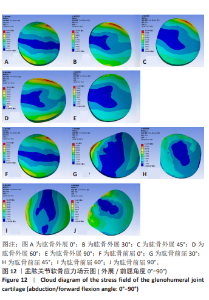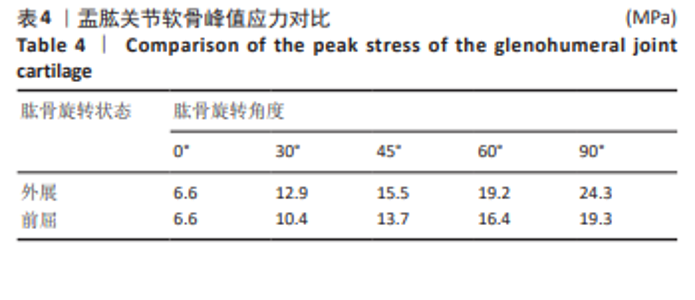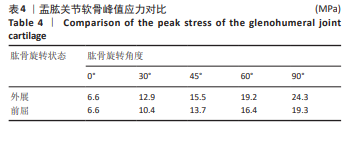Chinese Journal of Tissue Engineering Research ›› 2026, Vol. 30 ›› Issue (9): 2199-2207.doi: 10.12307/2026.098
Previous Articles Next Articles
Finite element analysis of the force changes of the supraspinatus tendon and glenohumeral joint during the abduction and flexion of the humerus
Zheng Wangyang1, Fei Ji1, Yang Di2, Zhao Lang2, Wang Lingli2, Liu Peng2, Li Haiyang3
- 1Guizhou University of Traditional Chinese Medicine, Guiyang 550001, Guizhou Province, China; 2First Affiliated Hospital of Guizhou University of Traditional Chinese Medicine, Guiyang 550001, Guizhou Province, China; 3School of Mechanical and Electrical Engineering, Zhengzhou University of Light Industry, Zhengzhou 450002, Henan Province, China
-
Received:2024-12-31Accepted:2025-03-27Online:2026-03-28Published:2025-09-05 -
Contact:Fei Ji, MD, Associate chief physician, Master's supervisor, Guizhou University of Traditional Chinese Medicine, Guiyang 550001, Guizhou Province, China -
About author:Zheng Wangyang, Master candidate, Guizhou University of Traditional Chinese Medicine, Guiyang 550001, Guizhou Province, China -
Supported by:2020年贵州省卫生健康委科学技术基金项目(gzwjkj2020-1-123),课题名称:关节镜下胸小肌松解对肩袖损伤预后影响的研究,项目负责人:杨砥
CLC Number:
Cite this article
Zheng Wangyang, Fei Ji, Yang Di, Zhao Lang, Wang Lingli, Liu Peng, Li Haiyang. Finite element analysis of the force changes of the supraspinatus tendon and glenohumeral joint during the abduction and flexion of the humerus[J]. Chinese Journal of Tissue Engineering Research, 2026, 30(9): 2199-2207.
share this article
Add to citation manager EndNote|Reference Manager|ProCite|BibTeX|RefWorks

2.1 Ⅰ型肩峰形态在肱骨外展角≤90°时未诱发肩峰下撞击征 此次研究证实,Ⅰ型肩峰(平坦型)在肱骨外展角度≤90°的生理范围内,未观察到肩峰下间隙显著狭窄或与冈上肌腱的异常接触现象。此结果提示,该肩峰形态在肩关节外展早期至中期(0°-90°)的生物力学环境下,对肩峰下结构的动态稳定性具有适应性保护作用。 2.2 冈上肌腱应力随肱骨外展角度呈非线性递增趋势 通过有限元力学分析,冈上肌腱的应力分布在外展过程中呈现显著角度依赖性(图11,表3)。外展角度从0°增至90°时,肌腱峰值应力由33.6 MPa上升至130.4 MPa(增幅287.5%),平均Von Mises应力由1.7 MPa增至8.0 MPa(增幅370.6%)。应力累积曲线符合指数增长模型(R2 > 0.98),表明冈上肌腱在外展运动中承担渐进性载荷传递功能,其力学响应特性与外展角度的平方呈正相关(P < 0.001)。这种现象对于深入理解冈上肌腱在肱骨外展机制中的力学特性以及相关的生理功能有着极为关键的意义。"

| [1] HAERING D, RAISON M, BEGON M. Measurement and description of three-dimensional shoulder range of motion with degrees of freedom interactions. J Biomech Eng. 2014;136(8). doi: 10.1115/1.4027665. [2] ENGIN AE, CHEN SM. Statistical data base for the biomechanical properties of the human shoulder complex--I: Kinematics of the shoulder complex. J Biomech Eng. 1986;108(3):215-221. [3] MCCAUSLAND C, SAWYER E, EOVALDI BJ, et al. Anatomy, Shoulder and Upper Limb, Shoulder Muscles. StatPearls. Treasure Island (FL) ineligible companies. Disclosure: Ethan Sawyer declares no relevant financial relationships with ineligible companies. Disclosure: Benjamin Eovaldi declares no relevant financial relationships with ineligible companies. Disclosure: Matthew Varacallo declares no relevant financial relationships with ineligible companies.: StatPearls Publishing Copyright © 2024, StatPearls Publishing LLC.; 2024. [4] FLORES DV, GOES PK, GÓMEZ CM, et al. Imaging of the Acromioclavicular Joint: Anatomy, Function, Pathologic Features, and Treatment. Radiographics. 2020;40(5):1355-1382. [5] POZZI F, PLUMMER HA, SHANLEY E, et al. Preseason shoulder range of motion screening and in-season risk of shoulder and elbow injuries in overhead athletes: systematic review and meta-analysis. Br J Sports Med. 2020;54(17):1019-1027. [6] CHANG RF, LEE CC, LO CM. Quantitative diagnosis of rotator cuff tears based on sonographic pattern recognition. PLoS One. 2019;14(2):e0212741. [7] SAMBANDAM SN, KHANNA V, GUL A, et al. Rotator cuff tears: An evidence based approach. World J Orthop. 2015;6(11):902-918. [8] NYFFELER RW, SCHENK N, BISSIG P. Can a simple fall cause a rotator cuff tear? Literature review and biomechanical considerations. Int Orthop. 2021;45(6):1573-1582. [9] ENSOR KL, KWON YW, DIBENEDITTO MR, et al. The rising incidence of rotator cuff repairs. J Shoulder Elbow Surg. 2013;22(12):1628-1632. [10] TOOTH C, GOFFLOT A, SCHWARTZ C, et al. Risk Factors of Overuse Shoulder Injuries in Overhead Athletes: A Systematic Review. Sports Health. 2020; 12(5):478-487. [11] LIN DJ, WONG TT, KAZAM JK. Shoulder Injuries in the Overhead-Throwing Athlete: Epidemiology, Mechanisms of Injury, and Imaging Findings. Radiology. 2018;286(2):370-387. [12] BEDI A, BISHOP J, KEENER J, et al. Rotator cuff tears. Nat Rev Dis Primers. 2024;10(1):8. [13] WESTERHOFF P, GRAICHEN F, BENDER A, et al. In vivo measurement of shoulder joint loads during activities of daily living. J Biomech. 2009;42(12): 1840-1849. [14] ISLÁN MARCOS M, LECHOSA URQUIJO E, BLAYA HARO F, et al. Behavior under Load of A Human Shoulder: Finite Element Simulation and Analysis. J Med Syst. 2019;43(5):132. [15] YANG Z, XU G, YANG J, et al. Effect of different loads on the shoulder in abduction postures: a finite element analysis. Sci Rep. 2023;13(1):9490. [16] CHAPMAN RM, TORCHIA MT, BELL JE, et al. Assessing Shoulder Biomechanics of Healthy Elderly Individuals During Activities of Daily Living Using Inertial Measurement Units: High Maximum Elevation Is Achievable but Rarely Used. J Biomech Eng. 2019;141(4):0410011-7. [17] 禹铭杨. 肩峰形态变异的临床意义及其对肩关节生物力学影响的有限元分析[D]. 长春:吉林大学,2015. [18] WAKABAYASHI I, ITOI E, SANO H, et al. Mechanical environment of the supraspinatus tendon: a two-dimensional finite element model analysis. J Shoulder Elbow Surg. 2003;12(6):612-617. [19] DUPREY S, BRUYERE K, VERRIEST JP. Human shoulder response to side impacts: a finite element study. Comput Methods Biomech Biomed Engin. 2007;10(5):361-370. [20] SANO H, YAMASHITA T, WAKABAYASHI I, et al. Stress distribution in the supraspinatus tendon after tendon repair: suture anchors versus transosseous suture fixation. Am J Sports Med. 2007;35(4):542-546. [21] 徐彪, 路坦, 姜亚琼, 等. 有限元分析不同程度冈上肌断裂对肩关节应力的影响[J]. 中国组织工程研究,2025,29(9):1768-1774. [22] REMIA LF, RAVALIN RV, LEMLY KS, et al. Biomechanical evaluation of multidirectional glenohumeral instability and repair. Clin Orthop Relat Res. 2003;(416):225-236. [23] 何仿. 人体肩关节三维有限元模型的建立、验证及在肱骨骨折机制研究方面的应用[D].上海:第二军医大学,2006. [24] 何仿, 苟三怀, 卜海富. 不同肩关节功能位置上肱骨三维有限元应力分析[J]. 临床骨科杂志,2006,9(6):559-561. [25] MCLEAN A, TAYLOR F. Classifications in Brief: Bigliani Classification of Acromial Morphology. Clin Orthop Relat Res. 2019;477(8):1958-1961. [26] ARNER JW, NOLTE PC, RUZBARSKY JJ, et al. Correlation of Acromial Morphology With Risk and Direction of Shoulder Instability: An MRI Study. Am J Sports Med. 2023;51(12):3211-3216. [27] MEYER DC, RAHM S, FARSHAD M, et al. Deltoid muscle shape analysis with magnetic resonance imaging in patients with chronic rotator cuff tears. BMC Musculoskelet Disord. 2013;14:247. [28] KAMONSEKI DH, HAIK MN, RIBEIRO LP, et al. Scapular movement training is not superior to standardized exercises in the treatment of individuals with chronic shoulder pain and scapular dyskinesis: randomized controlled trial. Disabil Rehabil. 2023;45(18):2925-2935. [29] RIBEIRO LP, COOLS A, CAMARGO PR. Rotator cuff unloading versus loading exercise program in the conservative treatment of patients with rotator cuff tear: protocol of a randomised controlled trial. BMJ Open. 2020;10(12):e040820. [30] BECHTOL CO. Biomechanics of the shoulder. Clin Orthop Relat Res. 1980; (146):37-41. [31] REUTHER KE, THOMAS SJ, SARVER JJ, et al. Effect of return to overuse activity following an isolated supraspinatus tendon tear on adjacent intact tendons and glenoid cartilage in a rat model. J Orthop Res. 2013;31(5):710-715. [32] YAMAMOTO A, TAKAGISHI K, OSAWA T, et al. Prevalence and risk factors of a rotator cuff tear in the general population. J Shoulder Elbow Surg. 2010;19(1):116-120. [33] LEWIS JS. Rotator cuff tendinopathy. Br J Sports Med. 2009;43(4):236-241. [34] KIM JH, JUNG SH. Delaminated Rotator Cuff Tear: Concurrent Concept and Treatment. Clin Shoulder Elb. 2019;22(3):159-170. [35] LONGO UG, BERTON A, PAPAPIETRO N, et al. Epidemiology, genetics and biological factors of rotator cuff tears. Med Sport Sci. 2012;57:1-9. [36] YANG Z, LIN Q, NIU Y, et al. Visualizing Trends and Bibliometric Study in Tissue Engineering for Rotator Cuff Injuries. Tissue Eng Part B Rev. 2025; 31(2):190-207. [37] SCIARRETTA FV, MOYA D, LIST K. Current trends in rehabilitation of rotator cuff injuries. Sicot J. 2023;9:14. [38] BIGLIANI LU, KELKAR R, FLATOW EL, et al. Glenohumeral stability. Biomechanical properties of passive and active stabilizers. Clin Orthop Relat Res. 1996(330):13-30. [39] SIGRIST B, FERGUSON S, BOEHM E, et al. The Biomechanical Effect of Bone Grafting and Bone Graft Remodeling in Patients With Anterior Shoulder Instability. Am J Sports Med. 2020;48(8):1857-1864. [40] KIBLER WB, SCIASCIA AD, GRANTHAM WJ. The shoulder joint complex in the throwing motion. J Shoulder Elbow Surg. 2024;33(2):443-449. [41] FOX AJS, FOX OJK, SCHÄR MO, et al. The glenohumeral ligaments: Superior, middle, and inferior: Anatomy, biomechanics, injury, and diagnosis. Clin Anat. 2021;34(2):283-296. [42] TUPE RN, TIWARI V. Anteroinferior Glenoid Labrum Lesion (Bankart Lesion). StatPearls. Treasure Island (FL) ineligible companies. Disclosure: Vivek Tiwari declares no relevant financial relationships with ineligible companies.: StatPearls Publishing Copyright © 2024, StatPearls Publishing LLC.; 2024. [43] DENG R, ZHAO R, ZHANG Z, et al. Chondrocyte membrane-coated nanoparticles promote drug retention and halt cartilage damage in rat and canine osteoarthritis. Sci Transl Med. 2024;16(735):eadh9751. [44] CHEN P, LIU X, GU C, et al. A plant-derived natural photosynthetic system for improving cell anabolism. Nature. 2022;612(7940):546-554. [45] CHOI MC, JO J, PARK J, et al. NF-κB Signaling Pathways in Osteoarthritic Cartilage Destruction. Cells. 2019;8(7):734. [46] LEPETSOS P, PAPAVASSILIOU KA, PAPAVASSILIOU AG. Redox and NF-κB signaling in osteoarthritis. Free Radic Biol Med. 2019;132:90-100. [47] FRANCESCHI F, GIOVANNETTI DE SANCTIS E, GUPTA A, et al. Reverse shoulder arthroplasty: State-of-the-art. J isakos. 2023;8(5):306-317. |
| [1] | Chen Huiting, Zeng Weiquan, Zhou Jianhong, Wang Jie, Zhuang Congying, Chen Peiyou, Liang Zeqian, Deng Weiming. Tail anchoring technique of vertebroplasty in treatment of osteoporotic vertebral compression fractures with intravertebral cleft: a finite element analysis [J]. Chinese Journal of Tissue Engineering Research, 2026, 30(9): 2145-2152. |
| [2] | Zeng Xuan, Weng Rui, Ye Shicheng, Tang Jiadong, Mo Ling, Li Wenchao. Two lumbar rotary manipulation techniques in treating lumbar disc herniation: a finite element analysis of biomechanical differences [J]. Chinese Journal of Tissue Engineering Research, 2026, 30(9): 2153-2161. |
| [3] | Cheng Qisheng, Julaiti·Maitirouzi, Xiao Yang, Zhang Chenwei, Paerhati·Rexiti. Finite element analysis of novel variable-diameter screws in modified cortical bone trajectory of lumbar vertebrae [J]. Chinese Journal of Tissue Engineering Research, 2026, 30(9): 2162-2171. |
| [4] | Wu Hongxu, Liu Xuanyu, Wang Taoyu, Wang Shiyao, Cheng Jingyi, Zhang Mingwen, Zhang Yinxia, Liu Zhihua, Wang Xiaojie. Finite element simulation of scoliosis with muscle unit introduction: verification of correction effect under bidirectional load [J]. Chinese Journal of Tissue Engineering Research, 2026, 30(9): 2172-2181. |
| [5] | Liu Jiafu, Ren Ruxia, Liao Zhouwei, Zhou Xiali, Wu Yihong, Zhang Shaoqun. Three-dimensional finite element analysis of cervical spine biomechanical characteristics in a rat model of cervical vertigo [J]. Chinese Journal of Tissue Engineering Research, 2026, 30(9): 2182-2190. |
| [6] | Zhou Daobin, Wang Kehao, Xie Yang, Ning Rende. Biomechanical characteristics of volar locking plate only versus combined dorsal mini-plate fixation of distal radius fractures with dorsal ulnar fragment [J]. Chinese Journal of Tissue Engineering Research, 2026, 30(9): 2255-2261. |
| [7] | Liu Wenlong, Dong Lei, Xiao Zhengzheng, Nie Yu. Finite element analysis of tibial prosthesis loosening after fixed-bearing unicompartmental knee arthroplasty for osteoporosis [J]. Chinese Journal of Tissue Engineering Research, 2026, 30(9): 2191-2198. |
| [8] | Cai Qirui, Dai Xiaowei, Zheng Xiaobin, Jian Sili, Lu Shaoping, Liu Texi, Liu Guoke, Lin Yuanfang. Mechanical effects of Long’s traction orthopedic method on cervical functional units: quantitative analysis of biomechanical model of head and neck [J]. Chinese Journal of Tissue Engineering Research, 2026, 30(9): 2208-2216. |
| [9] | Rao Jingcheng, Li Yuwan, Zheng Hongbing, Xu Zhi, Zhu Aixiang, Shi Ce, Wang Bing, Yang Chun, Kong Xiangru, Zhu Dawei. Biomechanical differences between the new proximal femoral stable intramedullary nail and traditional intramedullary nail#br# [J]. Chinese Journal of Tissue Engineering Research, 2026, 30(9): 2217-2225. |
| [10] | Chen Long, Wang Xiaozhen, Xi Jintao, Lu Qilin. Biomechanical performance of short-segment screw fixation combined with expandable polyetheretherketone vertebral body replacement in osteoporotic vertebrae [J]. Chinese Journal of Tissue Engineering Research, 2026, 30(9): 2226-2235. |
| [11] | Yan Xiangning, Chen Lei, Chen Yonghuan, Wang Chao, Li Xiaosheng. Influence of different depths and loads on knee joint mechanics and peripheral muscle force characteristics during squatting [J]. Chinese Journal of Tissue Engineering Research, 2026, 30(9): 2236-2247. |
| [12] | Zheng Xuying, Hu Hongcheng, Xu Libing, Han Jianmin, Di Ping. Stress magnitude and distribution in two-piece cement-retained zirconia implants under different loading conditions and with varying internal connection shapes [J]. Chinese Journal of Tissue Engineering Research, 2026, 30(8): 1979-1987. |
| [13] | Zhong Caihong, Xiao Xiaoge, Li Ming, Lin Jianhong, Hong Jing. Biomechanical mechanism of sports-related patellar tendinitis [J]. Chinese Journal of Tissue Engineering Research, 2026, 30(6): 1417-1423. |
| [14] | Xu Hao, Ding Lu, Li Xiao. Mechanical effect of mechanical wear of abutment screws on the Morse taper connection implant system: a three-dimensional finite element analysis [J]. Chinese Journal of Tissue Engineering Research, 2026, 30(6): 1375-1383. |
| [15] | Yu Xinlin, Chen Huiyu, Wang Yingying, Guo Weizhong, Feng Bin Lin Chengshou, Lin Wang. Finite element analysis of internal fixation with new retrograde intramedullary nail on lateral femur condyle for distal type A2 femur fractures [J]. Chinese Journal of Tissue Engineering Research, 2026, 30(3): 546-552. |
| Viewed | ||||||
|
Full text |
|
|||||
|
Abstract |
|
|||||



